![]()
![]()
![]()
Use LEFT and RIGHT arrow keys to navigate between flashcards;
Use UP and DOWN arrow keys to flip the card;
H to show hint;
A reads text to speech;
58 Cards in this Set
- Front
- Back
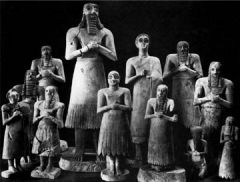
#14 Statues of votive figures, from the Square Temple at Eshunna modern Tell Asmar, Iraq Sumerian 2,700 B.C.E. _______________________ Content: These are gypsum carved, human statuettes that have been found in abundance in various Sumerian temples. They also have inlays of shell and black limestone. They are praying figures with enormous, stylized eyes and are found in many sizes. Some of the statues are children figures as well. _______________________ Style: Besides the eyes, there are other stylized features of these statues, like their body shapes and faces. The facial features are also more individualized and representative of certain humans rather than just a generalization of what humans look like. All of the figures are subtractivly carved and are meant to be seen from the front as there is no detailing on the backs. |
Context: These "votive" figureens give insight into the Sumerian religious rituals and beliefs that they were a part of. These statues were patronized or purchased by citizens hoping to look good in the eyes of the gods. The patrons would have the statues made in their likeness and placed in the "cella" of the temples so they could witness and been seen by the gods passing between heaven and earth. This was one of the reasons the figures had such big eyes, it was supposed to represent the patron's worship, awe, and receptivity of the gods. There placement in temple alters or something similar explains their decorative fronts and blank backs, they were meat to be placed in temples, and not moved, facing the area where the gods would come. Also, the different sizes of the figures did not also represent actual diversity among humans, instead it represented a hierarchal scale. More important and more wealthy patrons could purchase larger and more expensive stones to be carved and signify their importance. It was another step towards honoring the individual and their accomplishments, even if it was just bragging material to the gods. |
|

#15 Seated Scribe Saqqara, Egypt Old Kingdom, Fourth Dynasty 2,620 - 2,500 B.C.E. _______________________ Content: This is carved stone statue of a Egyptian scribe in a seated position, poised to start recording on a scroll. The piece has been painted and rests on a stone platform. _______________________ Style: This sculpture is more naturalistically carved (subtractive) and has intense coloring that gives it a more life-like quality. There are individual facial features and expression, as well as characteristic features of the body and attention to realism and detail. |
Context: The indicated carving is a piece of Egyptian funerary statuary that represents a deceased scribe and is meant to sit in his tomb and hold his spirit, or "ka", until he continues to the afterlife. The hierarchal standing of scribes at this time were high but not nearly as high as those of royalty. The scribe's status and purpose are depicted in his attentive expression and position with paper in hand. The fact that he is depicted in the action of writing shows that his position is society was still important enough to be noted. But, to make it known that he was still of a lower class than the pharaoh, the scribe is sculpted in a seated position and given realistic, natural features. By being seating, the statue is literary lower than any statue of royalty, giving the piece an important role in the hierarchal scale of Egyptian funerary statuary. The scribe is also depicted with a sagging chest and stomach that speaks to his age and status as a common man compared to the rugged posture of any royal statuary. But again, according with many of the stylized and practiced ideas of Egyptian art, obesity in statues was associated with rank. But giving the scribe a little fat than he may or may not have had, he is seen as having lived a relatively high class and comfortable life. |
|
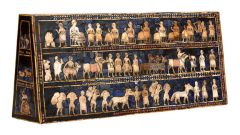
#16 The Standard of Ur from the Royal Tombs at Ur modern Tell el-Muqayyar, Iraq Sumerian 2,600 - 2,400 B.C.E. _______________________Content: The standard is a wooden box with lapis-lazuli inlays on all sides. There are mosaics coverings the surface made of lapis-lzuli and shell depicting scenes of royalty, war, peace, and snippets of the Sumerian's technological ingenuity and celebratory occasions. _______________________ Style: All the figures are stylized and in twisted perspective, with the horizontal registers acting as grounds for the figures to walk on. The registers also organize the piece into themed sections: War and Peace. The pieces of mosaic shell are carved with a subtractive technique to create generalized features for the human figures, animals, and objects. The dress of the figures (or on the Panel of War: lack thereof) is what mainly differentiates them. |
Context: The city of Ur was a center of Sumerian culture, economy, wealth, power, and sophistication of civilization that dominated much of the near east. The presence of lapis-lazuli speaks to the trade that the Sumerians established for semi-presious stones and metals like lapis-lazuli. Sumerians were able to trade industrially with places like India and Afghanistan. Since lapis-lazuli is rare and holds a dark, rich blue color, it has been a prized stone throughout history, including in the Sumerian culture. The stone was used only for significant, decorative purposes. It's use here in the Standard of Ur indicates that the piece was of great importance. Hence, the images it depicts must be of equal importance. There are two panels on either side: the Panel of War and the Panel of Peace. They both utilize horizontal registers to organize and separate the different parts of the events depicted. The top register is also seemingly the more importance, always holding the image of the king. On the Panel of War, the king is positioned in the center of the top panel and is so large that his head breaks the border around the image. This enlargement of the king illustrates the culture's need to focus attention on their royalty. The king appears taller on the Panel of Peace as well. The repetition of this speaks to intentional hierarchal imagery in the piece. On the middle section of the Panel of War, there are Sumerian soldiers dressed in garb and helmets herding naked prisoners of war. The prisoners were depicted nude becuase it was symbolic and related to the Mesopotamia idea that nudity is related to death. On the bottom register, the chariots and the animals pulling evolve as the eye moves from left to right. They start standing and eventually end up running. This was done to create movement, action, and speed through the changing positions of the animals. On the Panel of Peace side, there is a banquet with the king is sitting high on his stool and faced by six figures holding their cups up as a lyricist and supposed singer surround the scene. Below that section is one of people bringing food and then in the last section, there are people toting sacks and leading animals. This side is representative of how the Sumerians celebrated and also the different classes of people and their importance. The stylized, abstract figures speak to portray the importance of depicting the events rather than the individuals. The outline of the Standard of Ur is also similar to the way which Sumerian written language, "cuneiform", was laid out to be read. Cuneiform actually comes along not too long after this piece is created, meaning the layout of the standard was transitional from picture stories to a written language. |
|
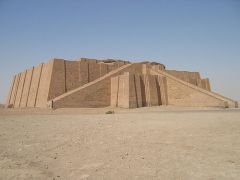
Ziggurat of Ur Dhi Qar Province, Iraq Sumerian 2,100 B.C.E. _______________________ Content: This is a stone ziggurat that probably housed a temple at its top. It's made from stone-cut squares and it's famous for the massive, diagonal and symmetrical staircases leading from the ground to the temple in addition to the frontal staircase. _______________________ Style: The ziggurat is elevated and meant to imitate a "holy mountain". It is solid, with very few windows. It also has the two diagonal staircases on either side and the frontal staircase. |
Context: This ziggurat was part of an administrative center for the city and was also thought to house the patron god of Ur, the moon god Nanna. In fact, the architectural design of the ziggurat was modeled after the eastern mountains where the gods were thought to visit, possibly explaining the diagonal staircases that give the building a triangular shape like a mountain. Of course, the ziggurat was built high off the group to bring the people and priests closer to the gods. |
|
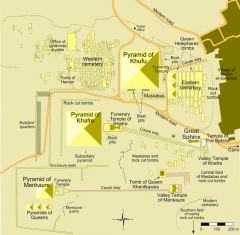
#17 Great Pyramids (Menkaura, Khafre, Khufu) & the Great Sphinx Giza, Egypt Old Kingdom - Fourth Dynasty 2,550 - 2,490 B.C.E. _______________________ Content: The complex that houses the Great Pyramids and the Great Sphinx also includes several cemeteries, a worker's village, and an industrial complex. Everything is made from pink sandstone and most is either sculpted from stone or constructed with stone blocks. The complex of the three Great Pyramids also has smaller "queens" pyramids, causeways, and valley pyramids. The Great Sphinx is to the east of the entire complex. _______________________ Style: All the Great Pyramids are massive pyramidal structures but the "Great Pyramid" of Khufu is the largest (450 ft tall with a base of 13 acres). The pyramids are spaced a couple of hundred yards apart and the sides of each pyramid are astronomically orientated with considerable accuracy. The base points of each pyramid are also alined with the four compass points. The Great Sphinx is also a massive carving the carries significance because of its size. Around the pyramid of Khafre, a "necropolis" and mortuary temple were found, along with a roofed causeway and valley temple. |
Context: The complexes of the Great Pyramids and the Great Sphinx are greatly infused with mythological and religious symbolism, including the shapes of the pyramids in relation to the sun king, Re. It also reflects the influence of Heliopolis, a leader in the cult of Re, and his symbol of the pyramidal stone. The pyramids were also representative of the god Re and his "rays" of sun that formed triangular shapes. Pyramids were also thought to be the place where kings were reborn. The sheer expanse of the complexes too, were built that way to satisfy the pharaohs in their afterlife. The necropolis and mortuary temple of Khafre was meant to be part of a funerary palace for the pharaoh in the afterlife. The Sphinx is also a mythological creature although it is thought that the face of the Great Sphinx is that of Khafre. |
|
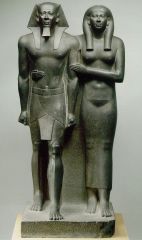
#18 King Menkaura and queen Egypt Old Kingdom - Fourth Dynasty 2,490 - 2,472 B.C.E. _______________________ Content: This is a piece of funerary statuary of Pharaoh Menkaura and his queen made of a hard, dense stone called diorite. It is formed in block-like structure and polished. _____________________ Style: The sculpture follows the cannon of proportions so popular that they were almost required in ancient Egypt. The figures are both rigid and physically appealing, with idealistic and iconic traits. Menkaura also sports the traditional headdress and beard of the pharaohs. Menkaura's wife and queen is depicted with a "wet drapery" style in her clothing. |
Context: The existence of funerary statuary for pharaohs in ancient Egypt goes back to the Egyptian's cultural obsession with death and the afterlife. Pharaoh's, especially, had lavish funerary practices and, in their statues, were expected to appear divine and powerful. Thusly, the "cannon of proportions" was created. The cannon was an exacting set of mathematical measurements that were used for almost all the royal sculptures. Artists who most closely followed the cannon gained the more respect. Because of this, there is very little artistic expression and the figures, including these, are stylized and iconic. Menkaura's beard and head piece are also including to upkeep Menkaura's position as pharaoh and remind people of his power and authority. Menkaura's wife and her wet drapery dress is also significant, the exposure of her shape represents fertility and royal blood lines. |
|
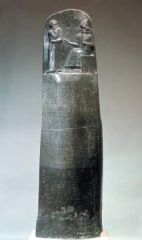
#19 The Code of Hammurabi Babylon, moder Iraq Susian 1,792 - 1,750 B.C.E. _______________________ Content: This is a basalt stone stella carved with written inscriptions and a top carving of Hammurabi in the presence of a "fire-shoulder" god. _______________________ Style: The writing is lightly chiseled into the stone whereas the scene of Hammurabi is subtractive and in high relief. The stone is also a dense material and was polished. |
Context: Hammurabi was the successful king of Babylon that dominated and flourished over Mesopotamia under Hammurabi's rule. The writing circulating the pillar is actually the 300 laws that governed Hammurabi's civilization. It gives proof that his reign created laws and enforced them as well. The writing also included consequences for breaking the laws, creating the first justice system that has been recorded. The depiction of Hammurabi with a god signifies the divine purpose for king Hammurabi's rule and his laws. |
|
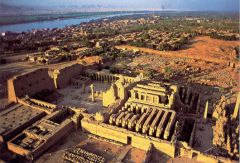
#20 Temple of Amun-Re and Hypostyle Hall at Karnak near Luxor, Egypt New Kingdom - 18th and 19th Dynasties _______________________ Content: This particular complex of the temple is massive: 7,270 acres. It consists of a "pylon" (stone wall surrounding the complex) that was painted with reliefs; there is also a causeway (a central road for ceremonies) that bisects the complex, dividing it into symmetrical sections; and finally, there is the Hypostyle Hall and obelisks. _______________________ Style: The pylon was built taller in the front, near the gate. The painted reliefs created decoration throughout the complex. The causeway running through the complex created symmetry of the temple, which was common at the time. The Hypostyle Hall itself is filled with columns covered in low relief carvings and hieroglyphs that had once been painted . The columns are also sculpted so that, even when viewed from the ground, they look perfectly straight. The architecture of the hall uses the column to hold pillions with windows to let light in. Lastly, the obelisks are free-standing at the back of the complex. |
Context: The shape of the complex came from many different pharaohs' additions to the original temple, thus obstructing the symmetry and creating innovative designs throughout the complex. The introduction of the claristory windows become one of those innovations that expand architectural history. The sculpting and decoration of the hypostyle columns represents the Egyptian need for perfection when honoring their rulers and also their incorporation of cultural symbolism through the inscribed hieroglyphs. |
|

#21 Mortuary Temple of Hatshepsut near Luxor, Egypt New Kingdom - 18th Dynasty 1,473 - 1,458 B.C.E. _____________________ Content: The temple is a rock-cut tomb that is for the most part cut out of the surrounding limestone walls with other stone features added on. Within the area of the temple there are also remnants of a sacred lake, gardens, lines of palm trees, and a causeway. There are also statues within the colonnades. _____________________Style: The facade of the building is dressed with colonnades, statues, and a causeway that separates the temple bilaterally and symmetrically. The statues on each column were painted at one point. The temple itself is constructed into three tiers and is about 97 ft tall at the top. |
Context: Hatshepsut was the first female pharaoh and although she ruled for about 20 years, she struggled to reinforce her authority as a rule because of her gender. As a reminder of her position as pharaoh even after her death, her temple holds many traditional Egyptian architecture, including the sacred lake, bilateral causeway, and statues. Inside the temple there were over 200 statues of Hatshepsut in pharaoh attire to solidify her image as a ruler. |
|
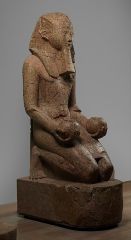
#21 Kneeling Statue of Queen Hatshepsut inside mortuary temple _____________________Content: This is one of many statues of Hatshepsut placed inside her temple. It is also one of her kneeling and making offerings to the gods in her traditional pharaoh head piece and beard. It is made from pink granite that had been polished. _____________________ Style: The statue is still iconic and stylized to represent the idealized features of a pharaoh and follows the cannon of proportions. Queen Hatshepsut is also carved with a slight wet drapery style that reveals her feminine figure. |
Context: The many statues like this one were created to immortalize Queen Hatshepsut's reign as pharaoh. Statues like this one were thought to hold the "ka" or spirit of the deceased pharaoh until they passed into the afterlife. Her kneeling position with offerings still reflects the religious influences and connections between pharaohs and the gods, while also maintaining the divinity of the pharaohs themselves. And even though Hatshepsut is always depicted in her head crown and beard, the wet drapery style is a reminder that she was still a female pharaoh. Unfortunately, for all her work in preserving her royal image, most of Queen Hatshepsut's statues were destroyed after her death in an iconoclasm led by the next pharaoh in succession. |
|
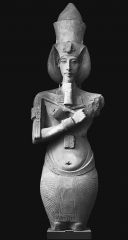
Statue of Akhenaton from Karnak Egypt The Armana Period 1,375 B.C.E. _____________________ Content: This is a sculpture of pharaoh Akhenaton with his crook, scepter, traditional head garb, and beard. The figure is 12-15 ft tall and is missing its legs. _____________________ Style: The style of the piece is strictly that of the Armana period. It defies the cannon of proportion for more stylized, humanistic, naturalistic elements. Every feature of the statue is elongated, the body is more rounded in a stylized manner and the face is longer too. The face also sports large facile features like full, feminine lips. In general, the form is more humanistic and approachable than those of previous art styles. |
Context: The Armana period only exsisted during Akhenaton's rule and changed many things about Egyptian religion and art. He was really an unorthodox pharaoh. During his rule, Akhenaton decreed that Egypt adopt a monotheistic religion that only recognized the sun god - Aton - the other gods were eliminated until after Akhenaton's rule ended. There is also a theory that Akhenaton had a genetic disorder that physically elongated his features and influenced his appearance, hence the different characteristics that appeared in sculpture during his reign. |
|
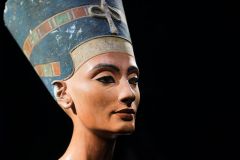
Nefertiti Egypt Armana Period 1,360 B.C.E. _____________________ Content: This is a bust of King Akhenaton's wife, Nefertiti. It is of limestone, is 19 inches in height and is painted. She is wearing the queen's crown, makeup, and ornamentation. _____________________ Style: Similar to the statues of her husband, Nefertiti's bust is elongated, naturalistic, and dapples in realism. There is a sensitivity to every facial feature, including the shape of the face, curves, ridges, etc. She is slightly stylized in the way she is modeled, elegant, and perfect, but there is still humanistic features. Her expression is soft enough to be friendly but she still holds a regal bearing and posture. The paint, too, is of vivid hue and gives the piece even more realism and humanism. |
Context: Similar to the other busts and representations found of Nefertiti, this one demonstrates advances technique skill in sculpture that is lost after the Armana Period. As a queen, Nefertiti is depicted with her crown, makeup, semi-precious ornamentation and regal bearing in order to hold the image of royalty. But the influences of the Armana Period create the elongated neck and face, soft, accurate features, and life-like paint. |
|
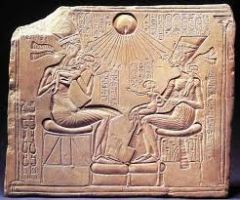
#22 Akhenaton, Nefertiti, and three daughters Egypt New Kingdom - Armana - 18th Dynasty 1,353 - 1335 B.C.E. _____________________ Content: This limestone commemoration shows Akhenaton and Nefertiti sitting with three of their daughters under the rays of the sun god. Akhenaton is also kissing one of his children. Both Akhenaton and his wife are wearing their traditional crowns. _____________________ Style: This piece is still stylized in accordance to the trends in the Armana Period, although it is still early on. The figures, including the babies, are elongated but still depicted in tradition twisted perspective. They are insized into the stone in ba and sunken relief with subtractive methods. The figures are naturalistic and, with the displays of affection, humanistic. |
Context: The family is shown basking in the "life-giving" rays of the sun god Akhenaton worshiped so devotedly. The god was symbolized as the sun disc with its rays of light. The figure's shapes and naturalism are contributed to the style of the Armana Period. And again, the supposed genetic disorder Akhenaton had is considered to be inherited, explaining the similar features of his three daughters. |
|
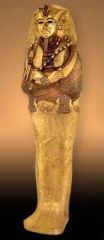
#23 Tutankhamun's tomb, innermost coffin Egypt New Kingdom - 18th Dynasty _____________________ Content: This is the most elaborate coffin of King Tut's and is the one that held the mummy. It has the boy king depicted with the traditional pharaoh crown, crook, and scepter, as well as engraved wings and hyroglifics along his middle and lower sections. _____________________ Style: Being the most decorative piece, the coffin is covered in gold, carnelian, lapis-lazuli, and turquoise. The sculpture of the coffin, inlays, and carvings are all very detailed. |
Context: King Tutankhamun was believed to be the son of Akenaton and ruled for 10 years before dying at age 18. The discovery of the tomb was what propelled the boy king into history because it had been untouched by tomb raiders. Everything, including the riches and the mummy itself was still untouched. It had remained that way because, in an act of iconoclasm, another pharaoh had sealed the entrance to King Tut's tomb behind a blank, limestone plaster wall and had built his own tomb around it. he innermost coffin of King Tut gives value to the young pharaoh and also shows the incredible skill that craftsmen at the time possessed when it came to working with gold. The inlays of writing and wings around the coffin represent the religious practices still very much associated with the burial services, also, the return of the other gods to Egyptian religion. |
|
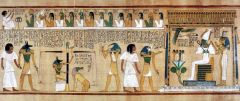
#24 Last judgement of Hu - Nefer, From his tomb (page from the Book of the Dead) Egypt New Kingdom - 19th Dynasty 1,275 B.C.E. _____________________ Content: This is a section of a painted papyras scroll that, in total length, is about 70 feet. It shows the pharaoh Hu-Nefer being led by the god Anubis to the scales of judgement. There are other gods depicted fulfilling their tasks as well like Osirus, his sisters, and the monster Ammit. _____________________ Style: All the figures are painted in twisted perspective and the piece is filled with cultural and religious symbols. The piece is also slightly divided with a horizontal register and also includes hyroglific writing. The gods also have respected animal heads and, in Osirus' case, are depicted green. |
Context: The scroll depicts the Egyptians beliefs of what happens after death and the gods ans symbols that relate to it. Anubis is leading the deceased because he is the god of embalming, an important ritual and first step in Egyptian culture to preserving the body and soul of the departed. The scales of judgement (an early representation of a common idea) were supposed to weigh a man's heart against the feafure of the goddess of truth, Mot. If the heart weighed more than the feather, then the person could pass into the afterlife. Those will heavy hearts would be eaten by the monster Attin whose name literally meant "devourer of the sinful". The threat of Attin and the scales, even as mythology, gave citizen's of ancient Egypt a motivation to live their lives without sin and acted, in a way, as a justice system which might be why scales are now associated with justice. At the end of the procession is Osirus, god of the underworld, and his sisters, Isis and Netersis, who grant eternal life. The appeal of immortality of the soul after death served as another motivation to live without sin. The depiction of many gods shows the transition back to a polytheistic culture. There are also representative symbols throughout the scroll that tell of the importance of religion and polytheism in ancient Egypt, including the onc, a symbol that represents life that is held in the hands of many of the gods. It is literally showing that the gods have the lives of mortals in their hands. |
|
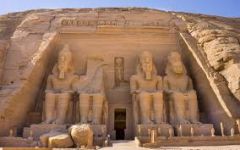
Temple of Ramses II Abu Simbel, Egypt New Kingdom 1,225 B.C.E. _____________________ Content: This was a rock-cut temple with four seated representations of Ramses II on the outside and many, massive statues (32 ft tall) serving as columns on the insides as well, along with paintings on the walls and roof. _______________________ Style: As the temple goes back towards the tomb, it gets smaller. All the columns and statues are carved with the tomb from the surrounding rock. Inside, the column representations of Ramses morph into images of Osiris the closer it gets to the back of the temple. The temple is a return to traditional styles and technical ability in Egypt. |
Context: Ramses was a pharaoh that ruled for 2/3 of a century, so his massive temple was only fitting for his long rule. The changes in the columns from showing Ramses to showing Osiris most likely were meant to convey the pharaoh's closer connection to the divine and also how, in death, Osiris is a major part of the Egyptian mythology and religion. The size changes as the tomb recedes back into the rock was an intentional technique, meant to restrict access except for a select few. The entire temple was also, at one point, deconstructed completely and moved 700 feet away from the bank of the Nile so it wouldn't be flooded with the installation of a modern damn on the Nile. |
|

#25 Lamassu from the citadel of Sargon II, DurSharrukin Modern Khorsabad, Iraq Neo-Assyrian 720 - 705 B.C.E. _____________________ Content: The Lamassu were mythological creatures depicted here as having the body of a bull, the face of a man (sometimes a king), and also wings. They were limestone carvings that were over 13 ft tall and were once secured to the gate of the city. _______________________ Style: The profile of the creatures is very interesting. At the front of the gate, they are shown in a frontal position and, as one passes through the gates, they are shown in profile. This makes a total of five legs that the creatures are depicted with. The legs on the frontal side are in a non-moving stance, but from the profile, they legs are in different positions to convey movement. |
Context: The Neo-Assyrian culture was a war-mongering society with a large military presence and many enemies. The large, strange mythological creatures were meant to be positioned at the front gate of the city to emanate power, strength, and authority and intimidate potential intruders. The statues also acted to remind the citizens to obey the authority and laws in the city. In short, the Lamassu were guardians of the city. It explains the strange perspective of the carvings, head on (from the perspective of intruders), the Lamassu were steady and looking out to protect the city. Upon entering the city, the Lamassu become more animated, something more to admired than feared. |
|
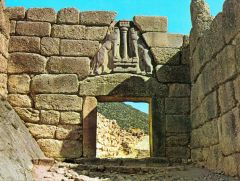
The Lion Gate islands of the Mediterranean, Greece Proto Greek / Mycenaean 1,400 B.C.E. _____________________ Content: This is a post and lintel gate, topped with an early arch that encases the scuptures of two lions (without their heads) on either side of a column. _______________________ Style: The design of this gate is pivotal because of the introduction of a "corralled" arch and movement away from a simple, undecorated post and lintel construction. The arch was created by staggering the stones in the gate to create a triangular space or, ideally, a curving shape. It's also remarkable how the lion details fit perfectly into the triangular space. The rest of the gate was created with "courses", horizontal rows of stone that made the corralled arch possible to build. |
Context: The Mycenaean culture was another war-farring civilization with heavily defended, elevated citadels for cities, protected by gates like this one. That could explain the use of lions as decoration, to communicate power and authority to anyone entering the citadel. |
|

Tholos Tombs "Treasure of Atreus" Proto Greek / Mycenaean 1,250 B.C.E. _____________________ Content: These were earth covered tombs that included large domes that were underground, but from above, could be seen as a hill. They were created from stone blocks. _______________________ Style: These were the first full domes in the ancient Mediterranean and still held a triangular shape that had come from the adoption of the corralled arch of the lions gate. These domes were essential the same design, just built higher and in a circular design. Within the tombs, there were also hammered gold designs that depicted battles. |
Context: The tombs were those of military associated people or those of a warrior king's. The hammered gold battle representations also spoke to the Mycenaean/Agamemnon culture that centered around war and honor. |
|
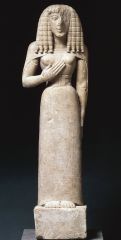
Lady of Auxerre Kore Archaic Greek 650 B.C.E. _____________________ Content: As a "kore", this is a sculpture of a young woman of limestone. And although classified as the sculpture, the figure is only 2 1/2 feet tall. It has been considered that the woman might be a goddess representation but it is thought more likely that she was just a common individual. _______________________ Style: The lady stands in a simplified pose, with some movement in the placement of one of her arms. The pedestal she rests on also gives idea to the stone from which she was carved from. Her hair is extremely stylized and geometric. There are many other features of this kore that are geometric as well, like her dress shape, clothing designs. But the same time, there is a blend with naturalism. The kore has a soft, modeled form and a wet drapery style on her top half that has naturalistic elements. Another surprising naturalistic feature: she's smiling! |
Context: At this time, Greek art is beginning to incorporate naturalism and humanism into its art. This is probably the reason for the kore's naturalistic form and small smile. The smile actually, becomes very characteristic of archaic greek sculptures. The smiles are always small and snarky but are still present and still add to the humanistic expression of the face. |
|

Temple of Artemis at Corfu on an island of Greece Archaic Greek 600 B.C.E. _____________________ Content: Today, only the pediment still exists but artist renderings give a good idea as to what the temple looked like in ancient Greece. The temple of basically just a cella with a colonial in front, holding up a decorated pediment that displayed artemis, two lions, and other figures. It was all sculpted from marble. _______________________ Style: The temple was made in the Doric style that was common in ancient Greece. This meant there were large, functional columns with larger drums than neckings that supported an overarching pediment decorated with triglyphs, metopes, and, in this case, high relief carvings. |
Context: Temples at this time were not funerary, but were built to appease the gods of ancient Greece and served as transitional places for gods moving between heaven and earth. The temples had more purpose religious purposes than decorative and so conveyed the Doric order of architecture. The temple was also elevated off the ground with a stereobate in order to bring the temple closer to the gods. The temple was also reserved for priests, priestesses, and royalty. Kings were allowed in because, although they were not gods on earth in Greece, they were the closest to them. Common people did not enter the temple. |
|

#26 Athenian Agora Athens, Greece Archaic through Hellenistic Greek 600 B.C.E. - 150 C.E. _____________________ Content: The agora was a public center for politics and economics in the city of Athen and became a cultural hub for the city. The area was large, open, surrounded by buildings of various business, and filled with public fountains and temples of the gods. ______________________ Style: The space was intentionally built on the convergence point of all three majors roads of Athens and was built large enough to host all different kinds of vanities of culture. |
Context: The Athenian Agora really became the cultural center of Athens and looked the part with different temples, markets, and spectacles. Court was often held in the agora so people could watch the system of justice and sentencing. In later times, the agora also hosting theaters and was used as a burial site. The complex was designed in part by Peilistratus, who had removed private houses from the area to created enough space for the agora. He had also created a drainage system for the area and commissioned many of the temples and fountains. The agora was sacked and rebuilt many times throughout the years, lending to it's somewhat jumbled appearance as new walls and buildings were took the places of ones that had been destroyed. |
|
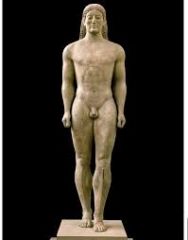
#27 Anavysos Kouros Archaic Greek 530 B.C.E. _____________________ Content: This is a sculpture of a young, Greek war hero. It's made of marble and is 6'4" tall. ______________________ Style: The statue shows great strides in the field of naturalism. The proportions of the body are so naturalistic that they border on realism. The rounded-ness of the body, face, torso, and limbs shows attention to the naturalistic elements. Still, the piece is still very much stylized about the face and hair. There are no individual characteristics except for the archaic greek smile that makes an appearance. |
Context: This statue was commissioned by the family of Kroises, the young man sculpted as the Anavysos Kouros, who died nobly in a battle. The statue was placed over his grave with an inscription to remember and mourn him. The sculpture is an example of family patronage of art, funerary statuary for the common people, and the advances made towards naturalistic, individual characteristics even if they are fully accomplished in this piece. |
|

#28 Peplos Kore from the Acropolis Archaic Greek 530 B.C.E. _____________________ Content: This is a sculpture of what is thought to be a goddess because of her clothing, the attribute that would have identified which goddess she was is missing along with her left hand. She is sculpted from marble and is 4' high and there are still traces of paint left. ______________________ Style: This kore, as compared to the Lady of Auxerre, is much more naturalistic. She has softer characteristics and features that enhances her feminine figure. She also bears the famous ancient greek smile. |
Context: This sculpture is mainly still preserved (and still carries traces of paint) because it was buried for 2,000 years after being knocked down at the Acropolis in a Persian raid. The Athenians always buried the destroyed pieces, so this one was no exception. The kore was originally though to be wearing a peplos (long, simple, belted, and woolen garment), until it was discovered she was wearing four pieces of clothing, one of which was only seen sported by goddess sculptures. It was then known that this sculpture was of a greek goddess but it still remains a mystery as to which one. |
|
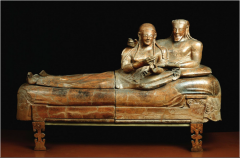
#29 Sarcophagus of the spouses Italy Etruscan 520 B.C.E. _____________________ Content: This is a piece of funerary statuary that was meant to honor and also to house the remains of a well-to-do couple in Etruscan society. It depicts the couple laying together on a sort of pedestal or couch. It's made out of terra cotta and was once painted. ______________________ Style: The terra cotta of the piece was cast and fired in four separate sections that were then compiled to create the full sarcophagus. The figures are depicted naturalistically but still with simplicity and a strangely Egyptian position of twisted perspective. The piece is also very humanistic with the subjects close together and interacting with one another in a loving manner. The terra cotta is very well polished and there is additional ornamentation on feet of the sarcophagus. |
Context: The Etruscan culture served as a "stepping-stone" culture between the Greeks and the Romans. It connected the two great powers and expressed shared ideas from both of them. What the Etruscans did not share, however, were their funerary practices. While the Greek buried their dead and marked them with stella and the Egyptians used mummification, the Etruscans cremated them and placed the ashes in sarcophagi like this one before placing the sarcophagi in tombs. Inside the tombs, the remains and their encasements were protected. This practice, along with the ideas behind it, let the Etruscans honor and celebrate the lives of their deceased. Another way they preserved the memory of their loved ones was through painting the terra cotta to give more accurate representations to the sculptures. |
|
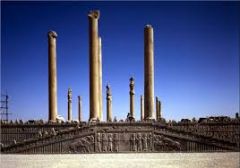
#30 Audience Hall (apadana) of Darius and Xerxes Persepolis, Iran Persian 520 - 465 B.C.E. ____________________ Content: The hall is part of a citadel that sits high on a plateau. The hall in now in ruins but the surrounding complex still includes an entrance gate to the citadel, ceremonial stairs and platform of the hall, and also a few of the massive columns that held up the hall roof. ___________________ Style: The audience hall stood on a platform led to by large, ceremonial staircases and able to house 10,000 standing guests. The hall had mud-brick walls and paved floors in stone or brick. The most noticeable feature, however, are the columns that once surrounded the hall. The columns had a total height of 64 feet, with tall bases, drums, and capitals. The entirety of the columns were fluted, and ringed with palm leaves on the bases. The capitals were decorated with volutes and topped with polished, painted, back-to-back animals and hybrid figures. There are griffins, bulls, lions, and composite man-headed bulls. The ceiling of the hall also included cedar beams as support. |
Context: The audience hall pictured provides important information about Persian art, architecture, influences, and ceremony. It is seen in ruins because the complex was razed by Alexander the Great, possibly as revenge for the Persian sack of the Acropolis. The Persians were, indeed, formidable enemies to Athens. The Persian Empire in the Achaemenid period spanned land from many areas and created the largest empire before Rome. The outer gateway for the complex was actually referred to as the "Gate of All Lands", referring to the harmonious way in which all the conquered lands of the Persian Empire lived. The inclusion of the column decoration was influenced by Assyrian, Egyptian, and Mesopotamic traditions and art. The man-headed bulls themselves are similar to the Neo-Assyrian lamassu in Iraq. The persepolis architecture of the hall must have wanted the strange beasts as decoration in order to convey the idea that the Persian king had enough power to captures those fierce animals and imprison them in his palace and have them serve him by holding the roof up. |
|
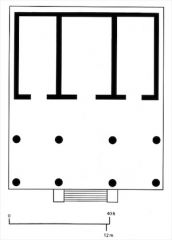
#31 Temple of Minerva and sculpture of Apollo Veii, near Rome, Italy Etruscan Artist: master sculptor, Vulca 510 - 500 B.C.E. ___________________ Content: This was an Etruscan temple to the goddess Minerva that was reconstructed and also included a statue of Apollo. It had three cellas, a raised floor and a colonnade. ___________________ Style: Although this temple held Greek influences, it's style held very acute differences. For example, the temple was more square than rectangular and utilized different building materials. The colonnades were wooden, the walls were of sun-dried mud brick, and the roof was tiled. The columns were also un-fluted and spaced more widely apart because of their light weight. They still held Doric influences but were still not identical to those of the Greeks. Entrance to the temple was only accessible from the narrow staircase that led to the temple floor. |
Context: This temple, although Etruscan, holds traces of the Roman ideals of propaganda through the building of public art and architecture. Not much is known about this temple and whether it was meant to convey such ideals because of the shattered state it was found in. The temple was reconstructed and the floor plans made from the notes of the Roman architect Vitruvius. The statuary of the temple was all terracotta (including the sculpture of Apollo) and was traditionally placed on the roof of the temple in the classic Etruscan fashion. |
|

#32 Tomb of Triclinium Tarquinia, Italy Etruscan 480 - 470 B.C.E. _____________________ Content: This is a subterraneal, multi-chambered family tomb cut of a dark limestone called tufa. Inside the tombs there are paintings depicting banqueting couples. ___________________ Style: These tombs were arranged in complexes and along streets like cities. The paintings inside them had Etruscan characteristics in the figure's exaggerated expressions and gestures with their enlarged hands. |
Context: This tomb, along with others like it, would be built together in a sort of "necropolis" of honorary sites. This tomb was that of a wealthy family and was a common practice for the people of the time. The painted banquet scenes depict happy couples with men painted darker than women to possibly establish gender roles or the differences between men and women in personality. The banqueters also encompass the famously Etruscan style of exaggerated guestures and big hands. All this was to create a joyful tone to the paintings and help them convey the Etruscan belief that death was a celebration of life. |
|
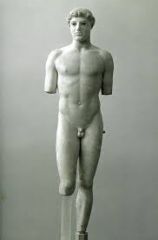
Kritios Boy Classical Greek 480 B.C.E. _____________________ Content: This is a marble statues that stands 2' 10" high and depicts a young man. ___________________ Style: This is the first accurate artist representation of the ways a human being actually stands. There is also a S curve in the figure's back that gives evidence to more realism and observance of the human shape. The piece also has the Greek smile that gives it a little more humanism. |
Context: This piece is representational of the transition between Archaic Greek and Classical Greek statuary. The Kritios Boy stands freely, with shifted weight that represents the ways humans actually stand in real life instead of following the stance of the stone and using supports. |
|

Temple of Hera II at Paestum Classical Greek 460 B.C.E. _____________________ Content: This is a marble temple of Hera, the second of its kind. ____________________ Style: This is a Doric style temple. It is raised on stereobate and has a perstyle colonnade that encircles the temple. The temple is symmetrical and had an expanded colonnade for a more spacious cella. |
Context: The Doric order of which this temple follows represents the focus on basic purpose rather than how decoration. The strong columns and heavy pediment kept the formation of post and lintel construction. The more spacious cella and surrounding colonnade allowed the temple to be entered from any point and displayed the public accessibility that temples like this one held for the Greek citizens. |
|

#33 Niobides Krater Classical Greek Artist: Anonymous vase painter known as the "Niobid Painter" 460 - 450 B.C.E. ___________________ Content: This is a ceramic piece, originally of red clay with black glaze to create a negative effect with light space figures and patterns surrounding the vase. The figures tell the mythological story of a the massacre of a goddess' children. ___________________ Style: The vase was wheel thrown, with the red clay created the backdrop for the black glaze in a style called under-glaze decoration. The glazed decoration includes a schematic illustration, which uses a landscape in order to tell a story. Looking at the figures, it is possible to discern the hills, ground, and background that are under and behind the figures. |
Context: The initials found on this vase identify it as one of the Niobid Painter's works. It is unclear, however, whether the initials pertained to a single artist, a group, or a collective studio. Still, the Niobid Painter's work was popular and there are many Classical Greek pieces that bear his initials. Vases like this one served no other purpose except to be on display to the public in areas like markets, temples, cemeteries, etc. This one is particular illustrates the myth of the goddess Niobid. Niobid was a goddess of beauty and had many children. She challenged the goddess Lido (mother of Artemis and Apollo) and Lido punished Niobid for the challenge by killing of of Niobid's children. The moral of the myth and the painted vase was: don't challenge the gods. The placement of vases like this and their morals in public places ensured that people would follow the morals and never challenge the gods. Ideas like this helped strengthen Greek religion and ideology. |
|
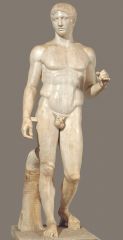
#34 Doryphoros (Spear Bearer) "Man of Opposites" Classical Greek Artist: Polykleitos original: 450 - 440 B.C.E. ____________________ Content: The Doryphorus is exactly what his title describes his to be: a spear thrower. He is a sculpture of a young man that once held a wooden spear in his left hand. ___________________ Style: The piece is very Classical Greek, with naturalism and something close to realism in effect. The posture of the statue is contraposo, with a relaxed, twisted stance and free arms and legs. To stand, however, the statues still needs additional sculpted support. |
Context: The sculptor of this piece, Polykleitos, created the Doryphoros to give evidence to a book Polykleitos had written entitled "Cannon". The book was all about the precise, mathematical measurements and proportions that could be used in sculpture to create the most realistic rendering of a human figure. This was similar to the "Cannon of Proportions" back in ancient Egypt but still held the Greek ideals of naturalism and humanism. The book of Polykleitos also explored the beauty that could be achieved when statues were carved using the harmonious, numerical ratios the "Cannon" described. When Polykleitos sculpted the Doryphotos, his ideas and book were accepted and utilized in Greece. Unfortunately, the "Cannon" is now lost in history. |
|
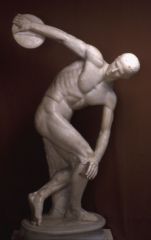
Diskobolos (Discus Thrower) Myron, Athens, Greece Classical Greek 450 B.C.E. _____________________ Content: This is the sculpted representation of a Greek discus athlete, carved in marble. ___________________ Style: This piece maintains an incredibly dynamic posture, and is very close to life-size. There are also still support systems behind the figure to keep it standing. |
Context: The unprecedented movement and posture of this piece encompasses the Greek's hope to truly represent the capabilities and possibilities of the human body. Athletes, because of this humanistic belief, were held in high regard. The athlete captured in the Diskobolos lives up the humanistic expectations, with strong features and a stance that suggests potential power. |
|

#35 The Acropolis Athens, Greece Artists: Iktinos and Kallikrates 447 - 424 B.C.E. _____________________ Content: This is a complex in Athens built on a prominent hill and consisting of a multitude of Greek temples, amphitheaters, statuary, etc. _____________________ Style: The Acropolis was built on a high, central point on the landscape. It was surrounded by a "propyla", a main gate and was mostly built using mathematical precision and Doric principals. |
Context: As the cultural, economic, artistic, and technological height of the entire Greek civilization, the city of Athens sought ways of expressing and celebrating their dominance over the Mediterranean. The Acropolis was a way to accomplish all of the above while simultaneously creating public spaces and honoring the gods, especially the patron god of the city, Athena. The complex also spoke to the Athenian pride. The people of the city had a superiority complex that, for the most part was understandably earned, lent itself to the creation of art dedicated to all things Athenian. Such works included the Parthenon, its pediment statuary, the Temple of Athena Nike, Victory adjusting her sandal, and the Plaque of the Ergastines. |
|

#35 Parthenon Acropolis, Athens, Greece 447 - 424 B.C.E. _____________________ Content: This was the main temple dedicated to Athena and which, at one point, housed the Athena Parthenos. It is somewhat in ruins but still stands. The temple is marble, has a large cella, two rows of columns, and a decorated pediment. ___________________ Style: The temple was built using the mathematical equation: x=2y+1. Meaning, the length of one side of the temple is twice the other side plus one, this also pertains to the number of columns on each side. The temple if mainly Doric but still hold innovation in its roomy cella and doubled colonnade. |
Context: According to the mythology, Athena was chosen as the patron god of Athens when she out-gifted the god Poseidon by creating the olive tree for the first king of Athens. The king chose her gift over Poseidon's salt-water spring and she became the symbol and adoration of the city of Athens. Indeed, many of the greatest temples of the Greek civilization were dedicated to her and built in Athens, including the Parthenon. The Parthenon also once housed a massive, regal statue of Athena called the Athena Parthenos which was supposedly decorated with ivory and gold. Sadly, the statue went missing in history. It was probably taken and/or destroyed in one of the many sack of Athens by the Persians and other empires. Nevertheless, the Parthenon still stands in tribute to Athena and, in order to share the glory of the goddess with every citizen of Athens and every tourist of the world, the temple is still designed to be entered from any point around it. |
|

#35 Helios, Horses, and Dionysus (Heracles?) Artist: Phidias Acropolis, Parthenon, Athens, Greece 447 - 424 B.C.E. _____________________ Content: These sculptures, named for what they portray, are massive sections that were meant to decorate the east pediment of the Parthenon. They depict gods, (possible) heroes, and normal spectators watching the birth of Athena. ___________________ Style: They are modeled in segments that fit together and then fit into the triangular section of the pediment. The show high technical and artistic ability. |
Context: These sculptures were part of the full pediment and its other sculptures interpreting the birth of Athena. It starts with the god Helios (god of the sun, also Apollo?) riding up in his chariot and horses, followed by a reclining Dionysus (or Heracles), and some spectators to Athena's birth that was supposed to be placed to the right. Those sections, however, are missing. During the rise of Christendom across Europe and elsewhere, crusades and other christian movements torn down the "pagan" representations and sculptures left by the Greek culture, including the rest of the east pediment. The pediment itself was still an elaborate praise to Athena, and a solidification of her mythological birth story. |
|
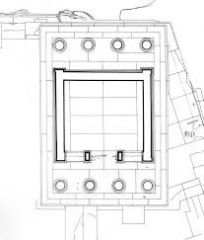
#35 Temple of Athena Nike Acropolis, Athens, Greece Artist: Kallikrates 447 - 424 B.C.E. _____________________ Content: This is another temple to Athena and Nike, a goddess of victory. It is much smaller than the Parthenon, but still sits on a sections of the Acropolis and overlooks the city of Athens. It includes a single cella and rows of columns attached to the walls. _____________________ Style: This temple was built it an Amphipro style that was later seen in Roman temples. The columns had ionic capitals and were free-standing in front of the facades on the east and west sides. The other sides were built with flat, undecorated walls. |
Context: The temple was built to commemorate an Athenian victory over the Persians. But to continue to show respect to the gods, the temple was dedicated to two goddesses that were attributed to the Persian defeat: Athena, goddess of wisdom and battle strategy and Nike, the goddess of victory. But despite the dedications to the goddesses, the temple was one of the first to celebrate human events rather than those of the gods. The need to recognize the event spoke to that Athenian pride that the citizens of the city had and the need they felt to commemorate their achievements right along side those of the gods. |
|

#35 Victory adjusting her sandal Acropolis, Athens, Greece 447 - 424 B.C.E. _____________________ Content: This is a marble carving that was once a section of a frieze that stood 3ft tall. _____________________ Style: It is carved in high relief and elaborate technical abilities displayed in the folds and movements of the clothing. The carving is also depicted in a unique position that suggests humanism and realism. |
Context: The fact that a goddess here is depicted adjusting her sandal, is a very humanistic choice. Normally gods were depicted in strong, divine stances so this carving is unique in the fact that the goddess Victory is depicted in the act of something very normal that can be related to any Athenian wearing the same kind of sandals. It creates a funny sort a scene with an elegantly clothed goddess |
|
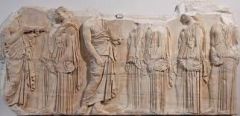
#35 Plaque of the Ergastines Acropolis, Athens, Greece 447 - 424 B.C.E. _____________________ Content: This was a section of the frieze that decorated the parthenon. It pictures a group of people partaking in a panaphanaic festival parade that used to happen every year in Athens as a holiday. _____________________ Style: The carving utilizes advanced proportional techniques used to make the carving viewable from the lower viewing perspective of people standing on the ground and looking up at friezes on the parthenon. The proportional illusion included a lower relief at the bottom of the frieze carving and a higher relief at the top. |
Context: The friezes of the parthenon were meant to convey stories and messages to the public of Athens. The effort that was put into the optical illusion in the Plaque of the Ergastines displayed the importance that all the decoration of the Parthenon could be viewed by anyone looking at it. Also, The festival parade that the the figured are pictured in was a celebration of humanity. |
|
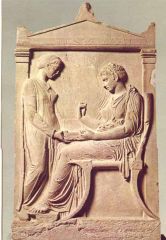
#36 Grave Stele of Hegeso Artist: Kallimachos 410 B.C.E. _____________________ Content: This is a carved piece depicting a sitting woman and her slave. It's made of marble and was once painted. _____________________ Style: This is a marble piece carved in low relief, with the seated woman carved larger than the slave. The piece was also once painted. The intimate scene of the two woman is a representation of the humanistic ideals of the the Greek culture. |
Context: The Greeks buried their dead and marked the ground with carved stella like this one, similar to gravestones. Since this grave stella is for a woman, abet a wealthy woman, this scene on it is a domestic one. This choice speaks to the gender roles of Greek civilization and the inferior place of women. But, the wealthy women still had people below them, like their slaves. This is why Hegeso is carved larger than her slave, in order to show the the hierarchal scale between master and slave. The two figures are also shown passing a family relic between them. The intimacy of the scene creates a humanistic element in the stella and is a look into the lives of Athenian. |
|
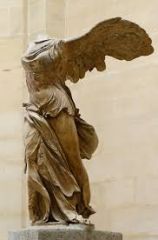
#37 Winged Victory of Samothrace Hellenistic Greek 190 B.C.E. _____________________ Content: This statue is of the winged goddess of victory and was originally the top section of a celebratory, public fountain where the statue stood over the prow of a Greek warship. _____________________ Style: The piece is very Hellenistic, with dramatic stance and movement. The clothing is highly ornamental and is sculpted in such a way that suggests the goddess is taking a stance against the wind. The statue is made of marble, was once painted, and is 8ft tall. Its unattainable height and elaborate detailing is a rejection of the rational cannon that was previously used in Classical Greece. The statue displayed the traditional realism realism but created more expressionism. |
Context: With the Greek empire at its peak, conquest overseas and in neighboring lands was crucial to the expansion of Greek culture. The Winged Victory of Samothrace was sculpted to represent Greek military power and conquest abroad. The goddess victory was sculpted with wings and standing on the prow of a Greek warship, symbolic of the Greek's belief that their military conquests were led by divine power. |
|
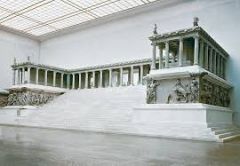
#38 Great Altar of Zeus and Athena at Pergamon Asia Minor (present day Turkey) Hellenistic Greek 175 B.C.E. ___________________ Content: This temple was built on a large mountain in Turkey and carved of marble. _____________________ Style: This temple was constructed much differently than traditional greek temples. It included a higher staircase and two arm-like structures of the temple coming forward from the main cella. The temple also includes a massive frieze with large, high relief sculptures and colonnades. |
Context: This temple was built near the end of the Greek empire, explaining the deviations it took from the classical Greek architecture. The unique frieze also was a new development in the temple's construction. It was too large and too low to be compared to the friezes on the Parthenon or other Greek structures. The figures sculpted on it were also very Hellenistic and the size and location of the frieze may have been made for the intention of displaying the figures. |
|
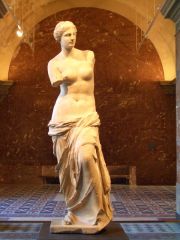
Venus di Milo Hellenistic Greek 150 B.C.E. _____________________ Content: This is a marble sculpture of the Goddess Aphrodite. _____________________ Style: The sculpture is very softly sculpted, with humanistic features in the fact that he clothes are coming off. |
Context: There was much controversy over this sculpture because a goddess had never been depicted in such a erotic pose. Goddess and gods were always represented as being structured, put-together, and divine. In this statue, however, the goddess of Aphrodite was put into a very normal, humanistic light. |
|
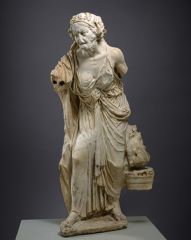
Old Market Woman Hellenistic Greek 100 B.C.E. _____________________ Content: This is a marble sculpture of an elderly woman, in Hellenistical sculpting clothing and carrying a basket. _____________________ Style: This elderly woman is sculpted with acute attention to reality and also hellenistic drama and expression. |
Context: This piece is very representative of the humanistic movement in Greece during the Hellenistic period that changed the subjects of sculpture from gods, to ordinary people. Since this woman is not divine, powerful, or youthful she would not normally be chosen for a sculpted piece. But the humanistic and hellenistic characteristics of her cloths, body, and expression create a new definition to beauty that speaks to the beauty of the human body itself, even in aging, rather than the traditional idealizations of beauty. |
|
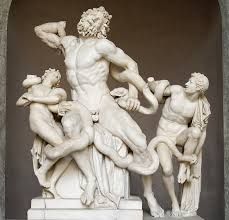
Laocoon (and his sons) Hellenistic Greek 100 B.C.E. _____________________ Content: This is a sculpture depicting the myth about how Laocoon and his sons were killed by sea serpents sent by Poseidon. _____________________ Style: With the same Hellenistic and realistic effects in this sculpture as seen previously, the sculpture also introduces a new way of keeping the scene together; All the figures in this sculpture are intertwined together by the serpents. It sparked a major theme in art that involved the intertwining of multiple figures to created movement and unite a work of art. The sculpture is also constructed with a pyramidal construction, with all attention being focused on the top point - Laocoon's aggrieved face. |
Context: The context of the myth that inspired this sculpture came from around the time of the Trojan War. When the Trojan horse was delivered to Troy with Greek soldiers inside, Laocoon (a priest of Apollo) protested the acceptance of the horse and even stabbed a spear through the side, piercing a Greek solider. But despite this, the Trojans accepted the horse and the Greeks one. The god Poseidon punished Laocoon and his two sons by sending sea serpents to kill them because Poseidon had wanted the Greeks to win and Laocoon's advice to reject the horse might have cost the Greek's their victory. The statue is meant to depict the exact moment the serpents descended on Laocoon and his family. The distressed and fearful facial expressions and movements of Laocoon and his innocent sons are what most contribute to the drama of this piece. |
|
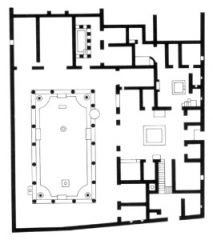
#39 House of Vettii Pompeii, Italy Imperial Roman original: second century B.C.E. rebuilt: 62 - 79 C.E. ___________________ Content: This was a private house (a dolmus) that was built like a complex with rented markets, an atrium, an impluvium (basin for collecting water), and several cubicula (small bedrooms). _____________________ Style: The house was also full of architectural advances and domestic engineering. In the atrium, there was an opening in the ceiling to let natural light in and also collect and channel water for the entire house. The floor plan was also laid out to categorize the areas of the house. The markets and businesses lay separated from the living quarters and everything was centered around the atrium. Most of the house was also decorated with elaborate frescos that employed painting techniques to make the rooms seem bigger. They utilized one-point perspective and decorative borders to achieve that purpose and also make the rooms seem more richly decorated with painted borders made to look like stone or columns. |
Context: A house like this was meant for display rather than the needs of its inhabitants. It centered around the Atrium, a semi-public greeting space and the largest and most central part of the house. Important guests were received there, so it could be seen by everyone that they were visiting the owner of the house. The inclusive markets and businesses were always an economical decision of the house owner. Shops and other ventures would pay the owner of the house to put up their business and the owner would also patronize and support certain artisans and clients. House owners would also entertain and involve themselves in political debates in their atriums. The Ixion room in House of Vettii is the one room with the most extensive frescos, they were painted to reflect and even exaggerate the wealth of the family and their importance. |
|
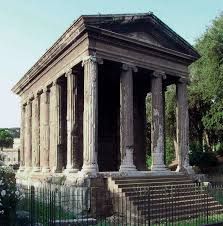
Temple of "Fortuna Virilius" Republican Rome 100 B.C.E. _____________________ Content: This is an early, marble temple of the Romans honoring a river god. _____________________ Style: It was built with great influences from the Etruscan culture, but with marble instead of wood and clay. The temple had frontal elevation but closed off walls for all sides except the entrance. The temple had six Ionic style columns. The columns the entrance are free standing but the rest are engaged columns - attached to the walls of the other three sides of the temple. |
Context: The stylistic elements of this temple speak to the Romans' habits of assimilating other cultures into their own. This temple in particular took from Etruscan designs but modified them to fit Roman standards. Since the Temple was still dedicated to a river god, it signified the Roman's continued dependance on their religious beliefs and the fact that they honored gods for what they had - like a profitable river port. |
|
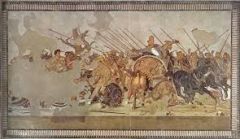
#40 Alexander Mosaic from the House of Faun Pompeii, Italy Republican Rome 100 B.C.E. _____________________ Content: This is a mosaic of the Battle of Issus that was fought between Alexander the Great and the Persian king, Darius. The mosaic decorated a wall in a dolmus in Pompeii. Although parts of the mosaic have fallen away, it still pictures Alexander riding in on the right on a single steed, and Darius turning and fleeing on the left in his chariot. The rest of the battle ensues around them, with fighting and falling soldiers, horses, and weapons (mostly spears). _____________________ Style: Made of tiny tiles of stone and glass called tessaria, this mosaic creates an in-depth picture on a 2-D surface. It includes naturalistic depth, reflections, and some twisted perspectives and proportions, like the twisted perspective of the horse near Darius's chariot. The movement in the piece also moves from left to right, in the direction of Alexander. The most dramatic element though, is the chilling, direct eye contact that is held between Alexander and Darius and serves as the focal point of the piece, lifting the eye above the chaos of the battle. |
Context: This mosaic was a form of Roman propaganda that was used in order to better publicize and worship the achievements of Roman's emperor, Alexander the Great, and also give credit to Rome's military power and conquest over its enemies. Alexander is depicted with perfect, attractive features and hair and is heroically riding on his own horse like any other man, unlike Darius who depends on his chariot. This scene is one from the Battle of Issus was the first time Alexander directly fought on the battle field with Darius. The conflicts between the Persians and the Greeks had carried over to the Persians and the Romans, lending to the tensed eye contact that the two empirical leaders hold in the mosaic. Alexander is also spearing a man as he looks at Darius, creating a meaningful and fearless message to the enemies of Rome. Lastly, the movement of the piece from left to right suggests that Darius's forces are in a full fledged retreat, moving away from the attacks of Alexander the Great and his men. Although the mosaic is still of a battle, it suggests that victory is already in the hands of the Romans and every person who viewed the mosaic knew that as well. |
|
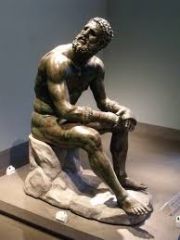
#41 Seated Boxer Hellenistic Greek 100 B.C.E. _____________________ Content: As the title establishes, this is a sculpture of a Roman style fighter, that probably fought for the entertainment of Roman throngs, similar to the purpose of the Roman gladiator fights. _____________________ Style: This sculpture is very Hellenistic, with accurate realism matched with emotional posture and expression. Unlike the majority of Greek sculpture, this one is made of bronze instead of marble. It's elaborate design, however, shows that the Hellenistic Greeks knew the techniques of heating, cooling, casting, and polishing bronze. Some of the most striking characteristics of this boxer is his broken nose, swollen ears, torn gloves and disquieted expression. It has also been found that the sculpture was once smeared with real blood to add a more realistic effect. |
Context: This sculpture is another that represents the Hellenistic movement away from the idealistic standards of beauty. The subject, in this case, is someone who doesn't compare with the traditional ideals of beauty. As a boxer, he is wounded and slightly disfigured about his face. Turns out, boxing has been a popular sport since the Sumerian times and throughout the ancient Mediterranean. In Greece, boxing was known as "Pyx", a form of the fighting style where victory was achieved through submission or a knockout. The matches were mainly fought with punches and with no other clothing except for the gloves, explaining the injuries displayed on this sculpture, as well as the use of real blood to gain to appropriate effect. It also explained the boxer's worried expression as his life's work was neither easy nor kind. Still, the fact that a lowly, beaten entertainer was selected to be the subject of this sculpture speaks to the Greek's want to celebrate the life of the common man. |
|
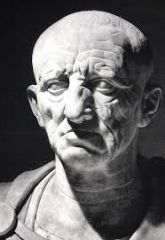
#42 Head of a Roman patrician Republican Roman 75 - 50 B.C.E. _____________________ Content: This is a carved, marble bust of a wealthy, elderly patron of the arts who was honored after his death with the bust. _____________________ Style: The bust has incredible realism, especially with the wrinkles and folds of the face. There was no idealism used to make the patrician look younger or more handsome than he was, it was all about accuracy. The eyes might have once been painted to create further life-like detail. |
Context: Deceased family members or wealthy members of society were always honored in Roman culture with a bust of their likeness that was placed in a room and sometimes held up and paraded about in ceremonial processions. The ideas of blood lines and family ancestry were very important in Rome, which might have led to the unyielding accuracy that Roman funerary busts required. If the busts were made accurately, families could look back and recall the exact look of their ancestors, even after generation had passed and no one could remember the actual person who had died. Still, the carving techniques of the busts depended on the assimilation of Greek ideas, including the close attention to naturalism and expression to create realism. |
|
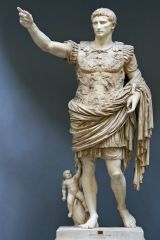
#43 Augustus of Prima Porta Imperial Roman Early first century C.E. _____________________ Content: This is a statue of one of the Caesar Rulers of Imperial Rome, presumably named Augustus. The man is pictured in fine clothes and has a little cupid at his feet. _____________________ Style: The style of this statue also takes a step back into idealism. Augustus is pictured with flawless features that he may or may have not actually possessed. His clothes are also not practical, but ceremonial and dramatically sculpted. He is shown raising and pointing in a stance of power. |
Context: This sculpture was more Roman Propaganda, mostly to support the ruling family of the Caesars. Statues of rulers like this once would be made in abundance and places around the ruler's territory to elevate their status and popularity among their people. The iconic and idealistic features of Augustus, the powerful placement of his stance, and fine clothes helped in the propaganda effect of this sculpture. The little cupid, as well, represented the divine purposes which backed Augustus's and the entire Caesar family's actions in ruling. |
|
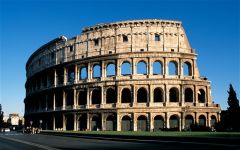
#44 Colosseum (Flavian Amphitheater) Rome, Italy Imperial Roman 70 - 80 C.E. _____________________ Content: This is a concrete and stone building that contains, or used to contain anyway, walkways, thousands of seating stands, a platform for fights and entertainment, and many sub level dungeons and tunnels. _____________________ Style: The structure was built with three tiers, with each in the style of the three orders of architecture. The lower has Doric characteristics, the middle had Iconic and the top has Corinthian. The facade of the Colosseum is also primarily constructed using arches, an architectural style hardly used until the Roman empire. The arches are seen in series and each have engaged columns and entablature. In the hay days of the stadium, there were also statues of the gods in each arch on the upper levels and flags lining the top. The construction of the arches included strong, basic post and lintel construction in top of which sat carefully cut stones called springers that held the arch. The arch was then built with more stones of varying cuts (voussoirs) to create the shape and then a key stone to top the arch and keep it stable. The arches are then extended to create tunnel arches that were uses and entrances and exits for the Colosseum. The arches also helped create the illusion of light and space in the structure, even though it was made of heavy concrete. At one point there was also an extendable cloth and wooden roof that could be put up and a wooden platform where the spectacles would happen over the cages and tunnels of the lower sections that houses the fighters and animals. To manage and seat thousands of spectators that came to watch the events the Colosseum displayed, it was built in a circular shape so it could be entered or exited at any point and people could also sit and watch from any point. Supposedly, there were also cranes that could move the platform area up and down for the enjoyment of the citizens who were watching. |
Context: Every Roman emperor always built some architectural wonder to honor their reign and keep them remembered after it ended. For emperor Flavian, it was the Colosseum. With it's grand appearance and purpose for providing entertainment to the Roman people, the Colosseum served both propaganda and utilitarianism purposes for Flavian. The Colosseum did , indeed, please the public of Imperial Rome and in doing so, promoted Flavian since he had commissioned the construction of the structure. The building also represented Roman assimilation of Greek culture because of the way it was constructed using early Greek orders of architecture. The events that took place in the Colosseum further testified to the greatness of Rome through the importation and display of people and animals from lands (like Africa) the Romans had conquered. |
|

#45 Forum of Trajan Rome, Italy Apollodorus of Damascus 106 - 112 C.E. _____________________ Content: This is a complex that served as a commemoration of Emperor Trajan that he himself commissioned. It included a center area, main gate, statues, markets, a basilica, and a column dedicated to Trajan's life story. _____________________ Style: The layout of this complex was different than any other in Greek and Roman times. It would later become the model that many christian churches would follow. The design led with a Roman arch in the gateway and then to an open area surrounded by a colonnade. The area had an equestrian statue of Trajan in the center. Further back was the Basilica, then the temple of Trajan with markets and libraries, and finally the column of Trajan in the back of the complex, similar to the obelisks of the ancient Egyptians. |
Context: Like what Flavian did with the Colosseum, The Forum of Trajan was Trajan's attempt to permanently establish himself in history as the greatest emperor of Rome. But instead of created just one marker of his reign, Trajan created many and centered them all in his forum. The entrance arch of the forum was symbolic in that time marked the beginning of something important or monumental, quiet a dramatic thing for the beginning of the forum. The equestrian statue was a mark of power since being depicted on a horse conveyed military power and authority. The rest of the complex spoke to different propaganda techniques that the Forum of Trajan employed and how they reflected positively on his rule. |
|
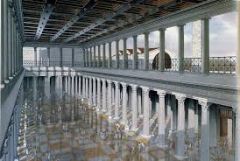
#45 Basilica Ulpia - reconstructive drawing Forum of Trajan 106 - 112 C.E. _____________________ Content: Although the extent of the Basilica Ulpia can only now be seen through reconstructive illustrations like this one, it was an elaborate area of the Forum of Trajan. The area was a reserved space for the politics of Rome. _____________________ Style: The area was covered and surrounded by a colonnade. And apparently, according to the drawing, the basilica also included high polished and decorative floors and ceilings. |
Context: This part of the forum mostly served a utilitarianism purpose for Trajan and the public. It was a place for politics and since Trajan had gifted the public a place for their political debates and appeals to the emperor, they were inclined to respect Trajan and his accomplishments. The basilica was also built in a sort of grandeur to further imply the importance and glory of Trajan and his forum. |
|
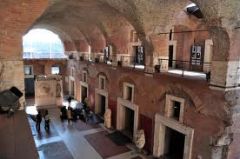
#45 Trajan Markets Forum of Trajan 106 - 112 C.E. _____________________ Content: The other parts of the forum besides the open areas, basilica, and temple were all filled with markets and libraries. _____________________ Style: The design for these sections were less grand and open than most of the forum. The markets and libraries needed less space and did not directly associate the achievement of Trajan with their purposes, so there was no need for added decoration to impress. |
Context: Unlike the basilica, which was to some extent off-limits to the majority of the public, the markets of Trajan involved and flourished through public involvement. Because of this, people would be drawn to the Forum of Trajan and consequently take in the propaganda of the place. The libraries too, also represented the Roman's advances in teaching and knowledge that was available to almost anyone. |
|
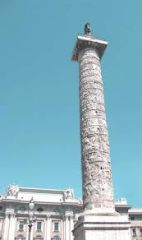
#45 Column of Trajan Forum of Trajan 106 - 113 C.E. _____________________ Content: This is a carved column that stands near the back of the Forum of Trajan. It includes inscriptions of Trajan's life story and the story of his death in order to honor him. _____________________ Style: The inscribed stories of Trajan are carved into the column with low relief. The column is incredibly large but really has no other decoration. |
Context: Just like it is Roman tradition for emperors to leave an architectural monument to themselves, it was also common for them to have a column that told their life story and how they died. It was just another way they solidifies the memory of their rule, power, and authority. |
|
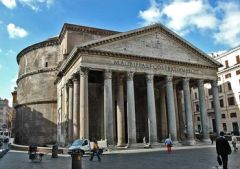
#46 Pantheon Imperial Roman 118 - 125 C.E. _____________________ Content: The pantheon is actually a temple dedicated "to all gods" and has the front of a traditional Greek temple while the back is a Roman dome. _____________________ Style: The two different parts of this structure hold two very different styles. The front has a colonnade and pediment, while the back is a resurrection of the ancient architectural shape: the dome. All of the outside is made from stone and concrete and the building is actually referred to as representing "the full potential of concrete". The base for the dome, the drum, was both a Greek and Roman concept. The interior of the dome is the most spectacular, however. The ceiling is coffered - covered in indented, ornate, and polished squares panels that require less concrete and expand the size of the dome. The coffered squares also eliminate much of the weight of the ceiling, allowing for the dome to be built as high as it is. There is also an oculus (an opening) at the very top of the dome that lets in light and eliminates the pressure on the point of the dome. The interior space is also decorated with stone veneer (slip stones put up against the concrete walls). |
Context: This temple was built by emperor Hadrian as his contribution to Roman society and to preserve his image as ruler of Rome. The Pantheon also represents the assimilation of Greek ideas and the addition of new Roman ones, literally! The front half of the temple keeps with Greek themes while the back is new, innovative Roman techniques. The coffered ceiling and decorated interior also speaks to the Roman's supreme engineering and design. |
|

#47 Ludovisi Battle Sarcophagus Late Imperial Roman 250 C.E. _____________________ Content: |
Context: |

